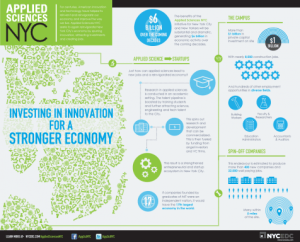NYCEDC: An Effective Means to a Worthy End
When Michael R. Bloomberg was sworn in as the 108th Mayor of New York City, he set out not only to revive the city’s economy after the September 11th attack but to transform it in ways not seen in decades. His administration’s primary vehicle for this transformation would be the New York City Economic Development Corporation (NYEDC). The NYCEDC was a highly effective medium because the agency’s business and operating models were aligned by the Bloomberg administration in a way to help them carry out their economic agenda.
Business Model:
NYCEDC’s mission is to promote economic growth throughout New York City. To accomplish this, the agency encourages business development and retention through use of city-owned property, tax incentives, loan programs, and direct subsidies[i]. In return, the city benefits from increased tax revenue via corporations and employees that relocate or stay as a result of NYCEDC initiatives.
Operating Model:
During Bloomberg’s tenure, NYCEDC operating model leveraged three assets in particular to create economic value for the city: Real Estate, Human Capital, and Marketing. These assets gave the city a leg up over its peers when it came to economic development. Furthermore, what’s interesting about these features is they were largely a manifestation of the unique political actor occupying the Mayor’s office, Michael R. Bloomberg.
Real Estate
With the ability to sell or manage the city’s vast real estate holdings, NYCEDC utilized this lever in a way typically not seen in municipal government. Rather than simply selling vacant lots to the highest bidders, NYCEDC focused on incorporating the city’s real estate assets as part of a broader economic plan. For example, the creation of the High Line Park in the Chelsea section of Manhattan was part of the Bloomberg’s administration’s efforts not only to produce more public space, but in turn create economic development in and around the West Chelsea neighborhood[ii].
Human Capital
Another lever of NYCEDC’s operating model during the Bloomberg Administration was the organization’s ability to attract to top talent to work at the agency. Drawn in large part to Mayor Bloomberg’s economic vision, a significant portion of the personnel within the agency came from venerable investment banks and consulting firms like Goldman Sachs and McKinsey & Company[iii]. With this kind of human capital in place, NYCEDC not only had the necessary technical expertise to negotiate better terms with potential parties, but the knowledge base to strategize the best economic way forward for the city[iv]. For example, encouraging the growth of the technology industry in the city by partnering with Cornell University to create a tech campus on Roosevelt Island.

Marketing
An important component of NYCEDC’s operating model was how the agency encouraged businesses to take advantage of everything the city had to offer. First, the Bloomberg administration changed the way the agency promoted itself[v]. The agency was rebranded from “New York City Economic Development Corporation” to “NYCEDC[vi].” Along with the renaming, a number of other brands were created to market the commercial enterprises of the city[vii]. Third, the focus of communications expanded not only to include the business community, but agency employees and the city at large[viii]. The enhanced marketing campaign was an effort to show NYCEDC’s expanded economic ambition during the tenure of Mayor Bloomberg[ix].
Going Forward
During the tenure of Mayor Bloomberg, NYCEDC’s business and operating models were aligned in a way that were highly effective in serving the aims of his economic agenda. The business model was enhanced by the operating model because the value businesses perceived as a result of moving or staying in New York was visible through the operating model (i.e. marketing campaigns and public spaces). This alignment allowed not only for an economic rebound following the downturn after September 11th, but also for economic growth in the years after. However, the question remains to be seen whether this model can be replicated in other municipalities effectively without a unique political actor such as Bloomberg.
Sources:
[i] http://www.nycedc.com/about-nycedc/-statement
[ii] http://www.nycedc.com/project/high-line
[iii] https://books.google.com/books?id=sFIko-CwZAsC&pg=PA124&lpg=PA124&dq=nycedc+under+mayor+bloomberg&source=bl&ots=IfRORQl5Cr&sig=iRaWiGti5WAVNVRmecam51IksTw&hl=en&sa=X&ved=0ahUKEwjU6LuGk9DJAhWIsh4KHRg2DAc4ChDoAQhDMAY#v=onepage&q=nycedc%20under%20mayor%20bloomberg&f=false
[iv] https://nextcity.org/daily/entry/exit-interview-the-nyc-economic-development-corporations-seth-pinsky
[v] https://books.google.com/books?id=sFIko-CwZAsC&pg=PA124&lpg=PA124&dq=nycedc+under+mayor+bloomberg&source=bl&ots=IfRORQl5Cr&sig=iRaWiGti5WAVNVRmecam51IksTw&hl=en&sa=X&ved=0ahUKEwjU6LuGk9DJAhWIsh4KHRg2DAc4ChDoAQhDMAY#v=onepage&q=nycedc%20under%20mayor%20bloomberg&f=false
[vi] https://books.google.com/books?id=sFIko-CwZAsC&pg=PA124&lpg=PA124&dq=nycedc+under+mayor+bloomberg&source=bl&ots=IfRORQl5Cr&sig=iRaWiGti5WAVNVRmecam51IksTw&hl=en&sa=X&ved=0ahUKEwjU6LuGk9DJAhWIsh4KHRg2DAc4ChDoAQhDMAY#v=onepage&q=nycedc%20under%20mayor%20bloomberg&f=false
[vii] https://books.google.com/books?id=sFIko-CwZAsC&pg=PA124&lpg=PA124&dq=nycedc+under+mayor+bloomberg&source=bl&ots=IfRORQl5Cr&sig=iRaWiGti5WAVNVRmecam51IksTw&hl=en&sa=X&ved=0ahUKEwjU6LuGk9DJAhWIsh4KHRg2DAc4ChDoAQhDMAY#v=onepage&q=nycedc%20under%20mayor%20bloomberg&f=false
[viii]https://books.google.com/books?id=sFIko-CwZAsC&pg=PA124&lpg=PA124&dq=nycedc+under+mayor+bloomberg&source=bl&ots=IfRORQl5Cr&sig=iRaWiGti5WAVNVRmecam51IksTw&hl=en&sa=X&ved=0ahUKEwjU6LuGk9DJAhWIsh4KHRg2DAc4ChDoAQhDMAY#v=onepage&q=nycedc%20under%20mayor%20bloomberg&f=false
[ix] https://books.google.com/books?id=sFIko-CwZAsC&pg=PA124&lpg=PA124&dq=nycedc+under+mayor+bloomberg&source=bl&ots=IfRORQl5Cr&sig=iRaWiGti5WAVNVRmecam51IksTw&hl=en&sa=X&ved=0ahUKEwjU6LuGk9DJAhWIsh4KHRg2DAc4ChDoAQhDMAY#v=onepage&q=nycedc%20under%20mayor%20bloomberg&f=false




Great example of how the public sector can engage the private sector. Agree with you though politics can make or break something like this… cf. MTR Corporation’s recent fiasco with their high-speed rail link project for an example of the latter
Really enjoyed this post, especially having previously worked at NYCEDC in their real estate division. I think your concerns about the need for mayoral leadership to replicate success are valid and would also add that this operational model might not be as easy to replicate in other cities that lack the core assets of New York City. The City of New York owns a vast array of prime real estate and has no problem attracting talented young professionals drawn to the NYC lifestyle. This is an example of a city leveraging its core assets but I wonder how other cities/regions can similarly align business and operating models when they lack the real estate portfolio or human capital pool of NYC.
As a New Yorker tried-and-true, thanks for the post! I certainly agree with you in that Mayor Bloomberg’s initiatives played a critical role in capturing the immense value embedded in New York City’s seemingly endless public assets. In addition to establishing economic incentives and business development programs, I think Bloomberg did a great job tapping into the pride of native and resident New Yorkers — these people want their city to be a beacon of modern society, personal and financial success, and fun. To meet this vision, local, homegrown businesses need to be able to flourish under the resources that the city could provide.